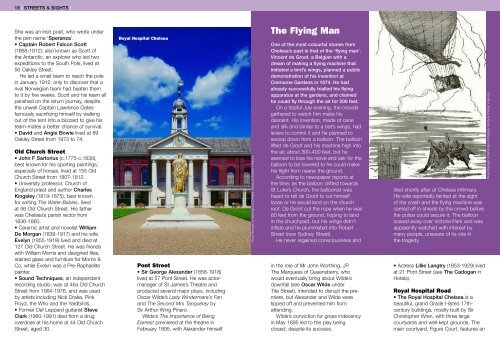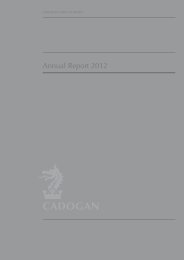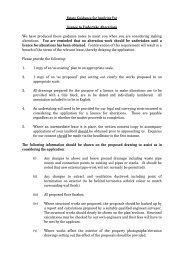The best of Chelsea by the people who know - Cadogan
The best of Chelsea by the people who know - Cadogan
The best of Chelsea by the people who know - Cadogan
Create successful ePaper yourself
Turn your PDF publications into a flip-book with our unique Google optimized e-Paper software.
18 | STREETS & SIGHTS |<br />
She was an Irish poet, <strong>who</strong> wrote under<br />
<strong>the</strong> pen name ‘Speranza’.<br />
• Captain Robert Falcon Scott<br />
(1868-1912), also <strong>know</strong>n as Scott <strong>of</strong><br />
<strong>the</strong> Antarctic, an explorer <strong>who</strong> led two<br />
expeditions to <strong>the</strong> South Pole, lived at<br />
56 Oakley Street.<br />
He led a small team to reach <strong>the</strong> pole<br />
in January 1912, only to discover that a<br />
rival Norwegian team had beaten <strong>the</strong>m<br />
to it <strong>by</strong> five weeks. Scott and his team all<br />
perished on <strong>the</strong> return journey, despite<br />
<strong>the</strong> unwell Captain Lawrence Oates<br />
famously sacrificing himself <strong>by</strong> walking<br />
out <strong>of</strong> <strong>the</strong> tent into a blizzard to give his<br />
team-mates a better chance <strong>of</strong> survival.<br />
• David and Angie Bowie lived at 89<br />
Oakley Street from 1973 to 74.<br />
Old Church Street<br />
• John F Sartorius (c.1775-c.1830),<br />
<strong>best</strong> <strong>know</strong>n for his sporting paintings,<br />
especially <strong>of</strong> horses, lived at 155 Old<br />
Church Street from 1807-1812.<br />
• University pr<strong>of</strong>essor, Church <strong>of</strong><br />
England priest and author Charles<br />
Kingsley (1819-1875), <strong>best</strong> <strong>know</strong>n<br />
for writing <strong>The</strong> Water-Babies, lived<br />
at 56 Old Church Street. His fa<strong>the</strong>r<br />
was <strong>Chelsea</strong>’s parish rector from<br />
1836-1860.<br />
• Ceramic artist and novelist William<br />
De Morgan (1839-1917) and his wife<br />
Evelyn (1855-1919) lived and died at<br />
127 Old Church Street. He was friends<br />
with William Morris and designed tiles,<br />
stained glass and furniture for Morris &<br />
Co, while Evelyn was a Pre-Raphaelite<br />
painter.<br />
• Sound Techniques, an independent<br />
recording studio, was at 46a Old Church<br />
Street from 1964-1976, and was used<br />
<strong>by</strong> artists including Nick Drake, Pink<br />
Floyd, <strong>the</strong> Who and <strong>the</strong> Yardbirds.<br />
• Former Def Leppard guitarist Steve<br />
Clark (1960-1991) died from a drug<br />
overdose at his home at 44 Old Church<br />
Street, aged 30.<br />
Royal Hospital <strong>Chelsea</strong><br />
Pont Street<br />
• Sir George Alexander (1858-1918)<br />
lived at 57 Pont Street. He was actormanager<br />
<strong>of</strong> St James’s <strong>The</strong>atre and<br />
produced several major plays, including<br />
Oscar Wilde’s Lady Windermere’s Fan<br />
and <strong>The</strong> Second Mrs Tanqueray <strong>by</strong><br />
Sir Arthur Wing Pinero.<br />
Wilde’s <strong>The</strong> Importance <strong>of</strong> Being<br />
Earnest premiered at <strong>the</strong> <strong>the</strong>atre in<br />
February 1895, with Alexander himself<br />
Royal Borough <strong>of</strong> Kensingon & <strong>Chelsea</strong>, Family & Children’s Service<br />
<strong>The</strong> Flying Man<br />
One <strong>of</strong> <strong>the</strong> most colourful stories from<br />
<strong>Chelsea</strong>’s past is that <strong>of</strong> <strong>the</strong> ‘flying man’.<br />
Vincent de Gro<strong>of</strong>, a Belgian with a<br />
dream <strong>of</strong> making a flying machine that<br />
imitated a bird’s wings, planned a public<br />
demonstration <strong>of</strong> his invention at<br />
Cremorne Gardens in 1874. He had<br />
already successfully trialled his flying<br />
apparatus at <strong>the</strong> gardens, and claimed<br />
he could fly through <strong>the</strong> air for 500 feet.<br />
On a fateful July evening, <strong>the</strong> crowds<br />
ga<strong>the</strong>red to watch him make his<br />
descent. His invention, made <strong>of</strong> cane<br />
and silk and similar to a bat’s wings, had<br />
levers to control it and he planned to<br />
swoop down from a balloon. <strong>The</strong> balloon<br />
lifted de Gro<strong>of</strong> and his machine high into<br />
<strong>the</strong> air, about 300-400 feet, but he<br />
seemed to lose his nerve and ask for <strong>the</strong><br />
balloon to be lowered to he could make<br />
his flight from nearer <strong>the</strong> ground.<br />
According to newspaper reports at<br />
<strong>the</strong> time, as <strong>the</strong> balloon drifted towards<br />
St Luke’s Church, <strong>the</strong> balloonist was<br />
heard to tell de Gro<strong>of</strong> to cut himself<br />
loose or he would land on <strong>the</strong> church<br />
ro<strong>of</strong>. De Gro<strong>of</strong> cut <strong>the</strong> rope when he was<br />
80 feet from <strong>the</strong> ground, hoping to land<br />
in <strong>the</strong> churchyard, but his wings didn’t<br />
inflate and he plummeted into Robert<br />
Street (now Sydney Street).<br />
He never regained consciousness and<br />
in <strong>the</strong> role <strong>of</strong> Mr John Worthing, JP.<br />
<strong>The</strong> Marquess <strong>of</strong> Queensberry, <strong>who</strong><br />
would eventually bring about Wilde’s<br />
downfall (see Oscar Wilde under<br />
Tite Street), intended to disrupt <strong>the</strong> premiere,<br />
but Alexander and Wilde were<br />
tipped <strong>of</strong>f and prevented him from<br />
attending.<br />
Wilde’s conviction for gross indecency<br />
in May 1895 led to <strong>the</strong> play being<br />
closed, despite its success.<br />
died shortly after at <strong>Chelsea</strong> Infirmary.<br />
His wife reportedly fainted at <strong>the</strong> sight<br />
<strong>of</strong> <strong>the</strong> crash and <strong>the</strong> flying machine was<br />
carried <strong>of</strong>f in shreds <strong>by</strong> <strong>the</strong> crowd before<br />
<strong>the</strong> police could secure it. <strong>The</strong> balloon<br />
soared away over Victoria Park and was<br />
apparently watched with interest <strong>by</strong><br />
many <strong>people</strong>, unaware <strong>of</strong> its role in<br />
<strong>the</strong> tragedy.<br />
• Actress Lillie Langtry (1853-1929) lived<br />
at 21 Pont Street (see <strong>The</strong> <strong>Cadogan</strong> in<br />
Hotels).<br />
Royal Hospital Road<br />
• <strong>The</strong> Royal Hospital <strong>Chelsea</strong> is a<br />
beautiful, grand Grade I-listed 17thcentury<br />
buildings, mostly built <strong>by</strong> Sir<br />
Christopher Wren, with three large<br />
courtyards and well-kept grounds. <strong>The</strong><br />
main courtyard, Figure Court, features an<br />
Royal Borough <strong>of</strong> Kensingon & <strong>Chelsea</strong>, Family & Children’s Service







